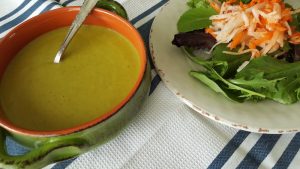This article comes from a Toolbox Talk created by the Safety Team.
As we already know, Summer and the heat that goes along with it is on its way. Along with the heat comes humidity which can make a 90º day feel more like 105º. There are charts that help us to determine what the heat index is by using both the temperature and the humidity. The higher the heat index the more dangerous it is to people that work or do activities outdoors.
It is talked about all the time to make sure to drink plenty of fluids during the heat of the summer months. But here, we are going to look at what foods to eat that will help to replace the fluids and essential vitamins and minerals.
Here is a list of foods that will help with these items.
Berries: Blueberries and black berries are more than 85 percent water while strawberries are 92 percent.
Broccoli: This cruciferous veggie appears dense but is 91 percent water.
Apples: An apple a day can help keep you hydrated, as a fruit is 84 percent water.
Pears: Eating a white-fleshed fruit, such as a pear, each day might cut your stroke risk in half.These hydrating fruits are 84 percent water.
Cherries: These tiny stone fruits are 80 percent water. If you eat a full cup of cherries (with pits) you will consume almost half a cup of hydration.
Grapefruit: Typically grown in the winter and spring, But the juicy fruit can still help hydrate you during the summer. Grapefruit contain about 91 percent water, with the red variety containing the most H2O.
Spinach: Is not only rich in nonheme iron, but also has 92 percent water and 23 calories.
Carrots: Not only can they help maintain your vision, they’re also 87 percent water.
Grapes: These berries are 81 percent water. They are high in vitamins K and C while grape seeds are full of additional antioxidants.
Oranges: Juicy oranges are 87 percent water, plus they are packed with vitamin C.
Pineapple: Juicy pineapple delivers the compound bromelain, a powerful anti-inflammatory agent. They are also about 87 percent water.
Cantaloupe: These melons are bursting with vitamins A and C and a compound called adenosine, which has heart-health benefits. Plus, they are 90 percent water.
Tomatoes: High is the antioxidant lycopene; red tomatoes are 94 percent water while the green variety is about 93 percent H2O.
Watermelon: This juicy treat is one of the most hydrating fruits, as 92 percent of the sweet red flesh is water.
Plums: Plums are stone fruits, a group shown to help prevent heart disease, stroke and type 2 diabetes. They are 85 percent water.
Cucumber: One of the summer’s favorite water packed veggies, cucumbers contains 96 percent water.
Mango: One cup of mango slices will give you more than a half cup of water.
Bell Peppers: Sweet red bell peppers have even more vitamin C than oranges. They’re also 92 percent water.
Celery: This veggie is a whopping 95 percent water.
Most of these items can be packed into you daily lunch and consumed during a quick break or lunch.
A cool idea that can be done with most berries is to put them into a zip lock bag and place in the refrigerator. In the morning, place them in the freezer for about 30 to 45 minutes prior to leaving home. Remove from the freezer and place in your lunch box. This can help in keeping your other food cool along with keeping them cool so when you eat them, it helps to cool you down as well. A favorite of mine is frozen grapes – they make a delicious hydrating and cooling snack.
As construction workers, we don’t always eat health, however during the heat of summer, there are foods best left alone. Spicy foods which contains capsaicin causes an increase in our body temperature. Diuretic foods which includes alcohol, energy drinks and caffeine and other foods can help to de-hydrate our bodies Last is high-protein foods such as steak and hamburgers, Protein causes the body to work hard to digest which creates heat in our body, so cut down on the amount of meat during hot weather.



No comment yet, add your voice below!